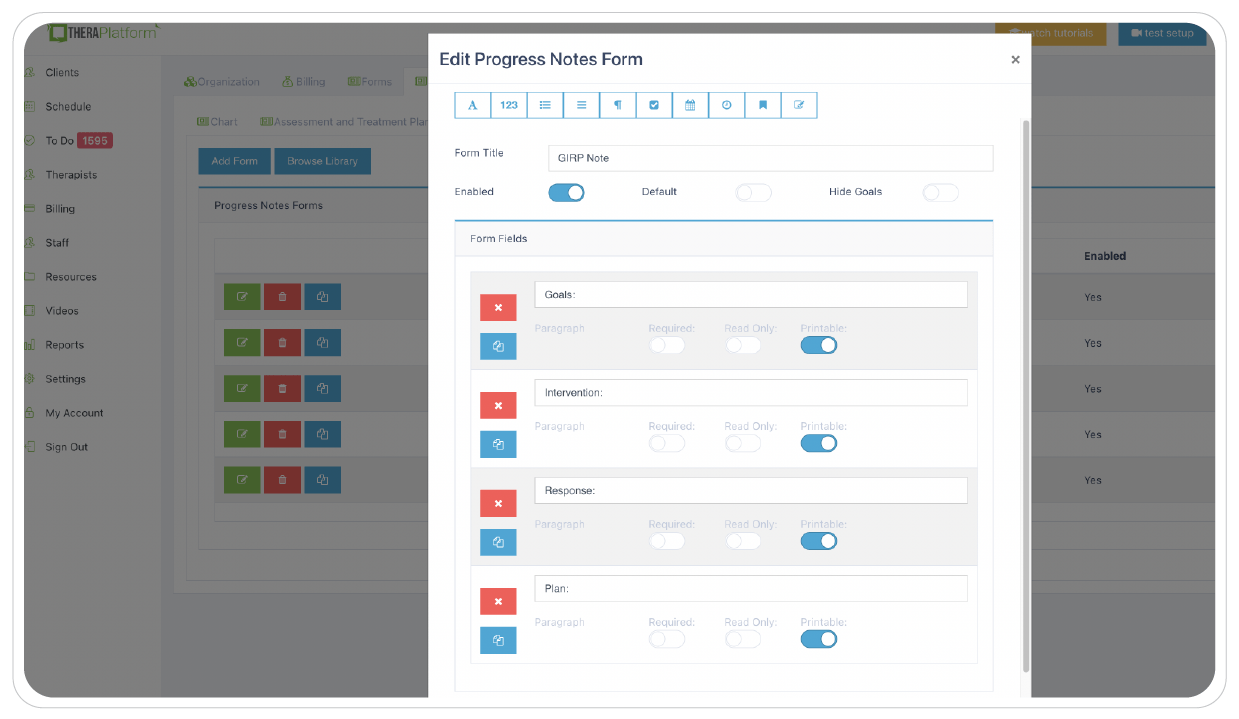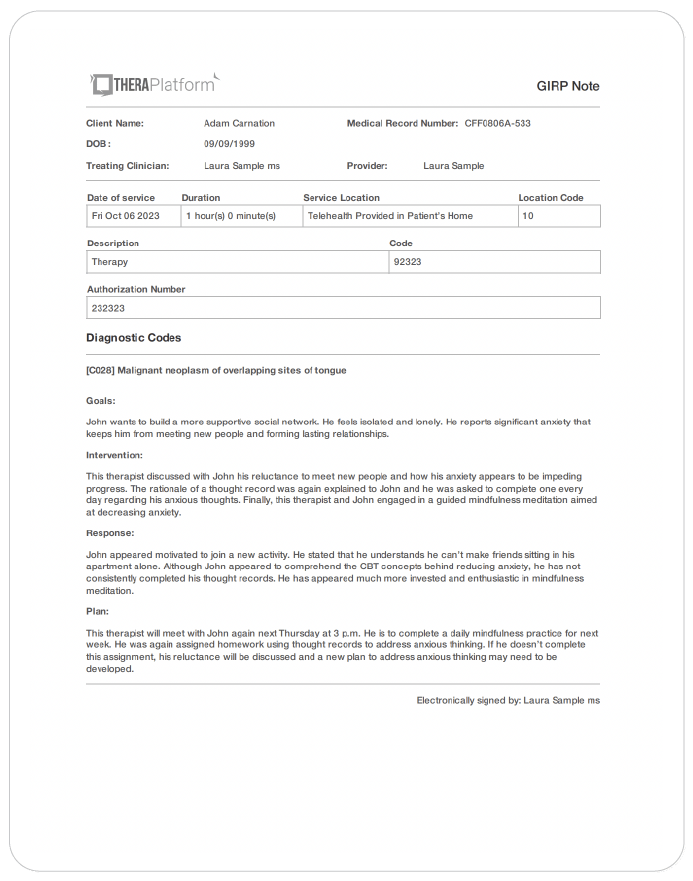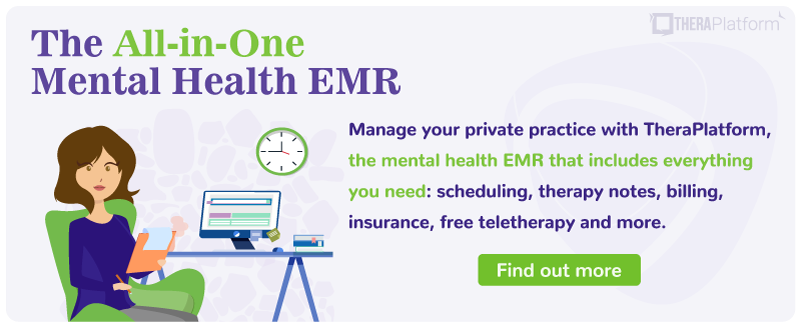GIRP notes

What is a GIRP note?
GIRP notes are a behavioral health progress note that can be used by clinicians to record treatment progress during a therapeutic session. GIRP stands for Goals, Intervention, Response, and Plan. GIRP notes are similar to other notes (e.g., SOAP and BIRP notes), except they emphasize achieving goals over analyzing client behavior. As such, you probably don’t want to use a GIRP note format unless the client is motivated to achieve a set of goals. Here is everything you need to know about GIRP notes.
Goals
Goals are what sets GIRP notes apart from other similar notes. The emphasis is on what the client wants to achieve, rather than on a specific behavior or client experience. This section can include both short-term and long-term goals. More than any other type of note, it reflects the progress made on goals established in the treatment plan. When you fill out the goals section of a GIRP note, you should know what the client is working towards, both in the present and the future.
The goals section of GIRP notes should provide the answer to the following questions:
- What brought the client to therapy?
- What does the client want to work on?
- What do you think the client should be working towards?
Tips for writing the goals section of GIRP notes:
- Use the SMART acronym as an effective tool for creating goals.
- Remark on both short-term and long-term goals.
- Make sure goals reflect the treatment plan.
- Don’t make goals that can’t be measured objectively.
Three examples of possible goals:
- John will build a more supportive social network as can be measured by the number of new friends (long-term).
- John will use cognitive restructuring to reduce anxiety by completing a daily thought record.
- John will reduce anxiety by performing one mindfulness exercise each day.
Intervention
The intervention section of GIRP notes state what methods are used to make the goals a reality. This part focuses on what the clinician did to work on the client’s objectives in the session.
The intervention section should provide the answer to the following questions:
- What interventions did the therapist use?
- How did the therapist help the client work towards achieving their goals?
- How were the client’s goals reflected in the intervention?
Tips for writing the intervention section of a GIRP note:
- A logical connection between goals and interventions should be evident.
- Action words (e.g., discussed, performed) are used to exhibit therapist interventions.
- Interventions should reflect the therapist’s theoretical orientation (e.g., CBT, psychodynamic).
- Don’t use an intervention that doesn’t fit your personal style, even if it sounds good.
Three examples of possible interventions:
- Therapist discussed with John realistic options for building a more supportive social network and decided on joining a new activity.
- Therapist explained the relevance of a thought record, showed John how to fill it out, and asked him to do so daily as homework.
- Therapist performed a guided meditation with John and directed him to an app to practice every day.
Response
The response section of GIRP notes detail the client’s response to the intervention. These responses should reflect the actual reaction in session, as well as client, reports as to their follow-through outside of treatment. This section is made up of both objective client behavior and subjective therapist interpretation.
The response section should provide the answer to the following questions:
- What is the client’s attitude toward therapy?
- Is the client making progress toward achieving their goals?
- Is the client struggling with any specific interventions?
Tips for writing the response section of a GIRP note:
- Use direct client quotes.
- Document physical observations of the client in session.
- Write down what interventions are working and those that are not.
- Don’t make interpretations that aren’t backed up by evidence.
Three examples of possible responses:
- John expressed hesitancy to go outside his comfort zone to participate in new social situations.
- John has been inconsistent in filling out daily thought records.
- John seemed receptive to mindfulness meditation and displayed evidence that he has been meeting his goals on the Headspace app.
Plan
The plan section of GIRP notes display the direction in which treatment is going.
It should provide the answer to the following questions:
- When is the date and time of the next session?
- Was the client assigned homework?
- What goals will be the focus of the next session?
Tips for writing the plan section of GIRP notes:
- Make sure the weekly GIRP notes plan reflects the overall client treatment plan.
- Note if the client has been referred to another specialist, such as for medication administration.
- Change up the plan if it isn’t working.
- Don’t ram homework down the client’s throat if they don’t consistently complete it.
Three examples of possible plans:
- The next therapy session with John is Thursday at 3 pm.
- John was assigned the task to continue daily mindfulness meditation.
- The therapist will explore John’s reluctance to complete thought record homework.
GIRP notes example
Here is an example of a well-executed GIRP note for our client John, who is suffering from social anxiety.
Client: John Doe
Date: xx/xx/xxxx
Goals
- Long-term goal: John wants to build a more supportive social network. He feels isolated and lonely. He reports significant anxiety that keeps him from meeting new people and forming lasting relationships.
- Short-term goals: John will join one new activity in the next two weeks. He will perform cognitive restructuring daily to address anxiety. Finally, he will establish a regular mindfulness practice.
Intervention
This therapist discussed with John his reluctance to meet new people and how his anxiety appears to be impeding progress. We talked about realistic options to meet people and it was decided he would join one new activity in the next two weeks. Additionally, the rationale of a thought record was again explained to John and he was asked to complete one every day regarding his anxious thoughts. Finally, this therapist and John engaged in a guided mindfulness meditation aimed at decreasing anxiety. He was tasked with completing a daily meditation on his own using the Headspace meditation app.
Response
John appeared motivated to join a new activity. He stated that he understands he can’t make friends sitting in his apartment alone. Although John appeared to comprehend the CBT concepts behind reducing anxiety, he has not consistently completed his thought records. He has appeared much more invested and enthusiastic in mindfulness meditation. He has downloaded the app and begun to participate in daily meditations.
Plan
This therapist will meet with John again next Thursday at 3 p.m. He is to complete a daily mindfulness practice for next week. He was again assigned homework using thought records to address anxious thinking. If he doesn’t complete this assignment, his reluctance will be discussed and a new plan to address anxious thinking may need to be developed.
GIRP notes are a comprehensive and efficient platform for keeping track of client progress in a behavioral health setting. What sets them apart from other progress notes is the focus on the client’s goals.
Start 30-day Free Trial and explore TheraPlatform. HIPAA Compliant Video and Practice Management Software for Therapists.
GIRP notes
Electronic Health Records (EHRs) have the potential to improve the efficiency and accessibility of GIRP (Goals, Interventions, Response, and Plan) notes in several ways. Integrating an EHR, alongside practice management software like TheraPlatform, can offer significant advantages to therapists in private practice:
Advantages of utilizing an EHR for GIRP Notes:
- Customizable templates streamline GIRP note creation: Some EHRs provide therapists with built-in templates for GIRP notes, simplifying the note-writing process. These templates can be tailored to meet the specific requirements of therapists' practices. Storing GIRP notes centrally in EHRs enhances accessibility.

Example: TheraPlatform's therapy note template library allows mental health professionals to browse and customize templates to suit their practice needs.
- Flexible note template builder: Some EHRs offer a template builder that serves as a base for GIRP note documentation. These templates are populated with essential fields, enabling therapists to easily complete various sections of a GIRP note. Therapists can customize templates to align with their preferred documentation style. The intuitive template builder saves time and offers customization options.

Example: TheraPlatform's form builder allows therapists to create templates from scratch with options like checkboxes, pick lists, and buttons.
- HIPAA-Compliant Storage: TheraPlatform prioritizes the secure storage of GIRP notes by employing encryption and robust security measures. They also provide legally-binding Business Associate Agreements, ensuring compliance with HIPAA regulations for safeguarding Protected Health Information (PHI).
- Secure and convenient note sharing: GIRP notes may need to be shared for various reasons, including increasing transparency in mental health care, providing clients with insights into their progress, or for insurance purposes. EHRs facilitate secure and easy access to GIRP notes, saving time compared to traditional paper-based methods like manual retrieval or faxing.
- Integration with Wiley Treatment Planners: TheraPlatform integrates with Wiley Treatment Planners, enabling therapists to quickly access evidence-based treatment objectives, interventions, homework assignments, and diagnostic codes like ICD-10 and DSM-5. This integration streamlines treatment planning, saving therapists valuable time.

Example: TheraPlatform's screenshot of GIRP note created with TheraPlatform. Stay consistent with GIRP note taking with templates.
- GIRP Note duplication: While the content of GIRP notes may change from session to session, certain information can be repetitive. EHRs allow therapists to duplicate relevant notes and retrieve data from previous sessions. Homework assignments from earlier plans can also be carried over, and notes can be edited as needed.
- Effortless signatures: TheraPlatform's Pro and Pro Plus plans offer the convenience of requesting electronic signatures directly on notes. This feature is particularly useful when working with pediatric clients, as it allows for signatures from parents or legal guardians. Clients can easily download and print these documents as required.
- Efax Integration: TheraPlatform, an all-in-one EHR, practice management, and teletherapy solution, offers efax integration. This eliminates the need to switch between multiple services, saving time and reducing costs by enabling seamless sending and receiving of documents such as GIRP notes via efax directly within TheraPlatform. No more fighting with the fax machine!
Leveraging an EHR like TheraPlatform helps therapists can enhance the quality and efficiency of their GIRP notes, streamline workflows, secure storage and easily access records.
Resources
Theraplatform, an all-in-one EHR, practice management and teletherapy software built specifically for therapists makes GIRP notes easy. Start your 30-day, free trial with no credit card required. Cancel anytime.
More resources
- Therapy resources and worksheets
- Therapy private practice courses
- Ultimate teletherapy ebook
- The Ultimate Insurance Billing Guide for Therapists
- The Ultimate Guide to Starting a Private Therapy Practice




